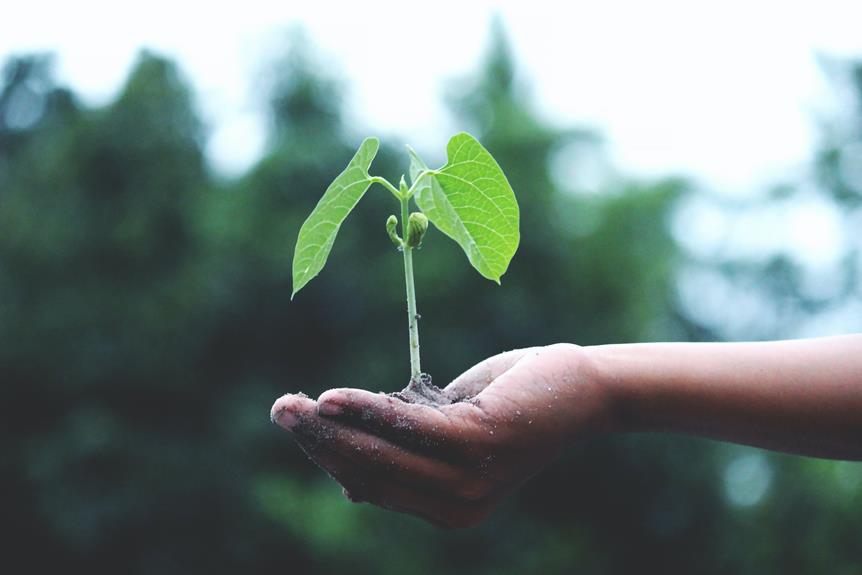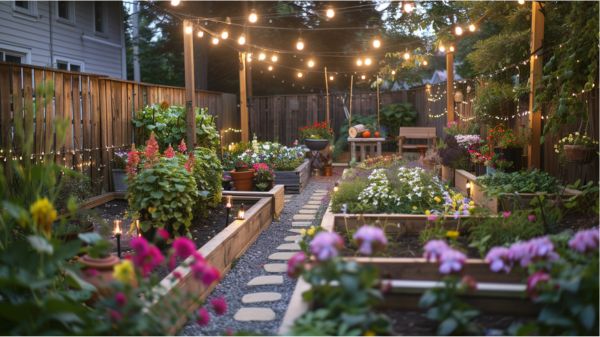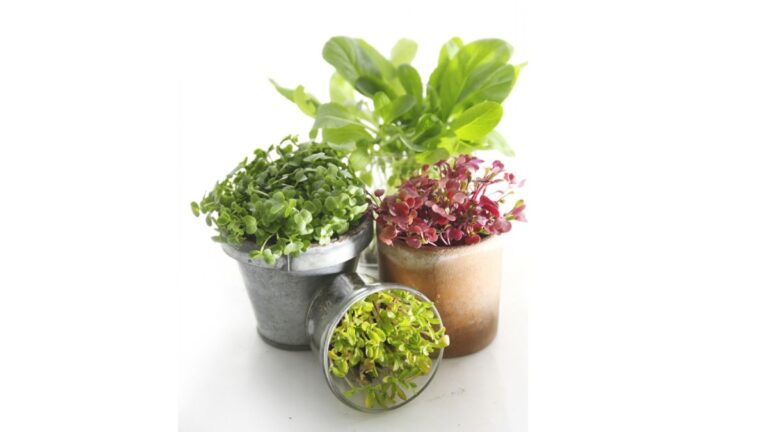15 Organic Soil Enhancement Tips for Outdoor Gardens
You’ve seen your neighbor’s garden flourish with vibrant blooms and robust vegetables, and it’s no secret that the magic lies in the soil. Like you, they know that a thriving garden starts from the ground up. That’s why we’re here to share 15 organic soil enhancement tips that’ll nurture your outdoor space.
These methods, steeped in the wisdom of seasoned gardeners, will help you enrich your soil naturally and sustainably. Together, we’ll explore how to assess your soil composition, create nutrient-rich compost, and foster beneficial soil organisms.
You’re not just improving your garden; you’re joining a community of earth-conscious growers dedicated to cultivating more than plants. So, roll up your sleeves and let’s dig in to create a garden that’s as alive and connected as the community around it.
Assessing Soil Composition
Before you enhance your garden’s soil organically, you’ll need to conduct a soil composition analysis to understand its current state. A soil test every four to five years is crucial; it provides data-driven insights into your garden’s soil structure, revealing whether you have dense clay soils or loose sandy soils.
Knowing your soil’s pH is also vital, as it affects nutrient availability to plants. If the pH is off-kilter, soil amendments like lime or sulfur can adjust it to an optimal range. This scientific approach ensures you’re not flying blind but instead nurturing a sense of belonging to the earth by working with its natural composition.
Composting Essentials
Every gardener should know that a generous amount of compost is key to enriching your garden’s soil organically. By adding organic matter through compost, you can improve soil structure, whether it’s clay or sandy, and bolster water retention. Use compost to provide your plants with a steady supply of nutrients, improve drainage, and maintain a neutral pH, fostering a thriving underground ecosystem of earthworms and microbes.
To make your own compost, start with a compost pile or use compost bins to manage your yard trimmings, kitchen scraps, and other organic materials. A well-maintained compost bin accelerates the breakdown process, ensuring you have a consistent supply. Remember, the key is balance—your compost should be a mix of green (nitrogen-rich) and brown (carbon-rich) materials, turned regularly for aeration.
Manure as Fertilizer
You’ll find that manure from different animals offers a range of nutrient contents suitable for your garden’s needs. Proper application techniques ensure that you maximize the benefits of these nutrients without harming your plants.
Additionally, composting manure before use not only makes it safer by reducing pathogens, but also stabilizes the nutrients, making them more available to your plants.
Manure Nutrient Content
In your quest for a fertile garden, understanding the nutrient content within various types of manure is key to optimizing soil health. Cow manure is a holistic choice, offering organic matter and a balanced array of nutrients. It’s not just about adding fertility; it’s about building a community within your soil that supports robust plant growth.
For a more targeted approach, consider sheep manure, which is particularly rich in nitrogen, crucial for your garden’s verdancy. When you calculate the needs of your soil, think about the nitrogen per 1,000 square feet ratio to tailor your application.
Horse and chicken manure can be more potent, with chicken manure being weed-free and exceptionally high in nitrogen, but it demands proper decomposition to prevent burning your plants. Rabbit manure, while lower in nitrogen, is also weed-free and contributes valuable organic matter and phosphorus.
Each type of animal manure uniquely meets your garden soil’s needs, fostering a sense of unity and belonging among your plants.
Application Techniques
How do you apply manure correctly to ensure it acts as an effective organic fertilizer for your outdoor garden? To be part of our growing community of garden enthusiasts, consider these scientifically-backed steps:
- Add an Inch: Spread well-decomposed manure over your garden bed, aiming to add about an inch. This boosts organic matter and nutrients without overwhelming plants.
- Mulch Around: After spreading manure, use it as a mulch around existing plants to improve soil structure and retain moisture, ensuring compost keeps feeding your soil.
- Cover Crop: For a long-term benefit, incorporate manure before planting a cover crop. This symbiotic relationship enriches the soil, creating a haven for your plants to thrive in.
Composting Benefits
By composting manure before adding it to your garden, you’re ensuring a safe, nutrient-rich fertilizer that will help your plants flourish. The composting benefits are manifold.
As organic materials like manure decompose and add to the compost pile, soil microorganisms break them down. This process not only produces a fertilizer that’s rich in nutrients but also improves soil structure. Composting converts manure into a form teeming with beneficial microbes, which, when introduced to your garden, enhance the soil’s nutrient profile and texture.
Furthermore, a well-decomposed compost acts as a slow-release fertilizer, providing a steady supply of nutrients. It boosts the soil’s ability to retain water and adds humus, ensuring your garden remains a part of a healthy, thriving ecosystem.
Using Leaf Mold
As you explore organic ways to enhance your garden’s soil, consider using leaf mold for its significant benefits. This decomposed matter increases your soil’s capacity to retain moisture, with studies showing it can hold 300-500% of its weight in water.
Moreover, when you add leaf mold, you introduce valuable humus, which enriches the soil and improves its structure, making it more fertile and robust for plant growth.
Creating Leaf Mold
You can significantly enrich your garden’s soil by making your own leaf mold, a simple process that transforms fallen leaves into a valuable organic amendment. This homemade treasure is a boon for your garden beds, nurturing a sense of unity between you and the natural cycle of decay and growth.
Here’s how you can create leaf mold:
- Gather fallen leaves and shred them if possible, as smaller pieces decompose faster.
- Place the shredded leaves in a wire fencing enclosure or a compost bin to retain moisture and warmth.
- Be patient; it can take 6 to 12 months for the leaves to fully break down into leaf mold.
Benefits to Soil
Incorporating leaf mold into your garden’s soil delivers myriad benefits, including enhanced moisture retention and improved fertility. As an organic amendment, leaf mold significantly elevates soil structure and texture, creating a hospitable environment for plant growth.
This organic matter isn’t just about boosting visual appeal; it’s about fostering a community within the soil, where water and nutrients are held efficiently, ensuring your plants have access to what they need to thrive.
Adding leaf mold can also improve drainage, preventing waterlogging that stunts root development. It’s the humus-rich character of leaf mold that enriches the soil, promoting Soil Health and establishing a robust foundation for your garden.
This dedication to nurturing your outdoor space with leaf mold reflects a commitment to sustainable practices that unite you with a global community of gardeners.
Mulching Techniques
To enhance your garden’s soil organically, apply a layer of shredded leaves directly onto the soil surface as mulch. Organic mulch isn’t just a blanket for your beds; it’s a transformative medium that nurtures good soil. Here’s how it works:
- Retains Vital Moisture: The layer of soil mulched with organic matter conserves moisture, reducing the need for frequent watering and protecting your plants from drought stress.
- Enriches with Nutrients: As the mulch decomposes, it slowly releases essential nutrients, enriching the soil with organic goodness.
- Suppresses Weeds: A robust mulch layer reduces weed germination, saving you time and effort in garden maintenance.
Collect soil samples periodically to monitor the improvement in soil texture and nutrient content. You’re not just gardening; you’re fostering a community of organisms that support robust plant growth.
Green Manures/Cover Crops
Transitioning from the benefits of mulching, let’s delve into how green manures, such as buckwheat and clover, can further elevate your soil’s fertility and structure. Cover crops, when incorporated as green manure, effectively improve soil organic matter. These living mulches are turned into the soil while still green, adding critical plant materials that enhance nutrient content and soil texture.
By choosing leguminous plants like clover, you’re inviting a natural nitrogen boost, crucial for the health of subsequent crops. These cover crops also help retain moisture, which is especially valuable during dry spells.
Remember, watering these plants during droughts ensures their growth and maximizes their soil-enriching properties. Together, we’re nurturing a community of gardens with rich, vibrant soils.
Crop Rotation Benefits
Your garden’s vitality hinges on practices like crop rotation, which replenishes nutrients and disrupts the cycles of pests and diseases. By thoughtfully alternating the types of plants you grow in each section of your vegetable garden, you’re investing in the land that unites us all.
Consider these benefits:
- Nutrient Balance: Different plants have unique nutrient needs and contributions. Crop rotation prevents nutrient depletion, as plant roots absorb varied nutrients and, in turn, leave the soil rich for the next crop cycle.
- Pest and Disease Disruption: By changing the buffet, you starve disease organisms and pests that prefer certain crops, thus protecting your garden’s legacy.
- Soil Structure and Health: Different crops contribute to soil organic matter differently, fostering a robust ecosystem below the surface that nurtures plant roots and soil life.
Worm Farming for Vermicompost
Building on the practice of crop rotation, you can further enrich your garden’s soil by starting a worm farm to create vermicompost. This organic compost is teeming with beneficial microorganisms and enzymes that significantly improve soil health and fertility. By managing a worm bin at home, you’re adopting a sustainable method that also recycles kitchen scraps and organic waste, showcasing your commitment to environmentally friendly gardening.
The vermicomposting process transforms organic matter into worm castings—a rich, dark vermicompost that enhances soil structure and provides plants with essential nutrients.
Embrace this data-driven approach to nurture your outdoor garden. You’ll foster a sense of belonging to a community of gardeners who value soil vitality as much as the harvest it yields.
Wood Ash Utilization
As you explore organic ways to enhance your garden soil, consider the role of wood ash. Wood ash can increase soil pH and add essential nutrients like potassium. When applying wood ash, it’s critical to adhere to recommended rates. Typically, no more than 20 pounds per 1,000 square feet annually is recommended. This is to avoid soil alkalinity reaching levels that might harm your plants.
Always wear gloves and a mask when applying wood ash to protect yourself from the fine particles. Additionally, ensure that the ash is cool and from untreated wood. This is important to avoid introducing harmful substances into your garden.
Wood Ash Benefits
While you mightn’t think of it as a conventional fertilizer, wood ash can be an excellent addition to your garden’s soil, providing essential potassium and helping to raise the pH level when necessary. Here are three ways wood ash can improve your organic garden soil:
- Boosts Potassium Levels: Essential for plant growth, wood ash supplements your garden with this vital nutrient, promoting healthier plants.
- Modifies Soil pH: It can gently increase the pH of acidic soils, making it more hospitable for a variety of plants.
- Acts as a Liming Agent: By neutralizing soil acidity, wood ash can serve as a natural amendment, improving garden soils without synthetic chemicals.
Application Rates
You’ll need to add a precise 5-10 pounds of wood ash per 100 square feet of garden soil to optimize your outdoor garden’s health.
As a community of organic garden enthusiasts, you understand the importance of maintaining soil vitality. Sprinkling wood ash can increase soil organic matter and elevate pH levels, ensuring a robust environment for your plants.
However, balance is key. To complement wood ash, consider integrating horse manure, which will enrich the soil with nitrogen, or add peat moss to bolster water retention.
For an extra boost, incorporate wheat straw or alfalfa meal, both of which are fantastic organic additions that enhance soil structure and fertility.
Safety Precautions
Before adding wood ash to your garden, it’s crucial to take certain safety precautions to protect both your plants and yourself. Here are steps to ensure you’re using wood ash safely:
- Store wood ash properly: Keep it in a dry place to prevent clumping and ensure it’s free of harmful additives.
- Handle with care: Wear gloves and protective clothing to avoid skin irritation from the caustic properties of wood ash.
- Apply correctly: Ensure the ash is cool before spreading and use it sparingly, particularly in organic gardens with heavy clay, to avoid excessively raising the pH of acidic soil.
Mix it into the first few inches of compost to improve drainage and aeration without harming acid-loving plants or causing compaction in your soil.
Rock Dust for Minerals
Incorporating rock dust into your garden’s soil is a straightforward way to supply your plants with an abundance of essential minerals. This natural resource infuses your organic garden with calcium, iron, magnesium, and phosphorus, vital for vigorous plant growth. By adding rock dust, you’re not just feeding your plants; you’re enhancing the soil structure, fostering a habitat conducive to beneficial microorganisms.
Using rock dust, an inorganic amendment, also helps in rejuvenating depleted soils, ensuring your garden maintains good drainage and a balanced nutrient profile. Embrace this scientifically-proven method to elevate your garden’s health. You’ll join a community of gardeners who prioritize sustainability and witness a bountiful harvest enriched with minerals.
Seaweed and Kelp Amendments
Building on your garden’s mineral foundation with rock dust, seaweed, and kelp amendments can further enrich your soil’s health and fertility. As you nurture your organic garden, remember that soil must be more than just dirt; it should be a living, breathing foundation teeming with nutrients and life.
Seaweed and kelp are great amendments that offer a host of benefits:
- Structure & Aeration: They improve the physical structure of the soil, enhancing aeration and drainage.
- Water Retention: These amendments increase the soil’s ability to retain moisture, reducing the need for frequent watering.
- Nutrient Supply: They’re packed with essential nutrients and minerals, fostering rich soil that supports vibrant plant growth.
Incorporate these common amendments into your garden to add soil vitality and foster a sense of community with nature’s intricate web of life.
Homemade Organic Teas
You can create your own nutrient-rich organic teas by mastering specific brewing methods that extract maximum benefits from chosen ingredients. When selecting components for your tea, it’s crucial to focus on those that offer a balanced mix of nitrogen, phosphorus, and potassium, as well as trace minerals.
To ensure your garden reaps the full advantages, you’ll need to apply these homemade teas at appropriate frequencies, which vary depending on plant needs and soil conditions.
Brewing Methods
To boost your garden’s vitality, brew a homemade organic tea using compost, worm castings, and other organic materials. This scientifically-backed practice will nurture your organic garden, creating a sense of unity with nature as you enrich the soil.
Consider these steps:
- Combine Ingredients: Mix bagged amendments like bone meal into your compost to enhance nutrient content. This blend fuels your soil’s food web.
- Aerate: Oxygenate the mixture to support microbial life, crucial for converting organic matter into plant-available nutrients.
- Apply with Care: Drench your soil and compost, ensuring even distribution and absorption, fostering a thriving underground community.
Adding materials such as homemade organic teas to your garden is a data-driven strategy to augment soil aeration, moisture retention, and fertility, solidifying your belonging in a community of eco-conscious growers.
Ingredient Selection
Selecting the right ingredients for your homemade organic teas is crucial to providing your garden with the best possible nourishment and enhancing its overall health. When you add organic matter like compost to your brew, you’re infusing soil nutrients that foster a healthy garden soil. Compost, rich in beneficial microorganisms, is the backbone of a thriving organic garden soil.
To specifically improve clay soils, consider worm castings, which introduce aeration and vermicompost tea. These elements aren’t only data-driven solutions for compacted earth but also encourage a sense of community among eco-conscious gardeners like yourself.
Application Frequency
While determining the ideal frequency for applying homemade organic teas to your garden, it’s essential to consider both plant needs and soil conditions. As you integrate these nutrient-rich solutions, remember:
- Regular Application: Apply every two to four weeks during the growing season, adjusting as necessary.
- Pre-Planting Boost: For best results, start adding compost tea to the soil two to three weeks before planting.
- Observation and Adjustment: Monitor your garden’s response over several months, tailoring application frequency to support robust growth.
Your commitment to this process fosters a sense of community with fellow garden enthusiasts who also value sustainable practices. By being detail-oriented and data-driven, you’ll see your garden thrive, thanks to the thoughtful application of these nourishing teas.
Soil Aeration Practices
You’ll significantly improve your garden’s health by regularly aerating the soil, a key practice that enhances its structure and facilitates better drainage and air flow.
Soil aeration practices prevent the tendency of earth to compact the soil, especially where foot traffic and heavy rains are common. Compact soil layers can impede the movement of air and water, stifling your plants’ ability to thrive.
Incorporating organic matter is essential; it separates clay particles, making it easier for roots to expand and for essential nutrients to circulate. When you allow water and air to freely reach plant roots, you foster a community of microorganisms essential for a vibrant ecosystem.
Ph Level Balancing
Before adding amendments to your garden, it’s crucial to balance the soil’s pH level to meet the specific needs of your plants. pH level balancing is the key to unlocking a thriving organic garden. You’re not just adjusting the earth; you’re nurturing a living community beneath your feet.
Consider these steps in your journey to harmony:
- Conduct a soil test: Understand your starting point. Is your soil acidic or alkaline? This knowledge is power.
- Choose the right amendment: Lime can raise a low pH, while sulfur can lower an excessively high pH.
- Monitor and adjust: pH isn’t static. Regular testing ensures your soil continues to hold nutrients effectively, preventing poor soil from undermining your hard work.
Beneficial Soil Organisms
Incorporating beneficial soil organisms into your garden’s ecosystem is a fundamental step toward enriching its vitality and productivity. These tiny allies, including earthworms, beneficial insects, bacteria, and fungi, are the unsung heroes of your organic garden. They decompose organic matter in compost, turning it into rich nutrients that plants thrive on.
By mixing in quality compost or using a nutrient-rich potting mix, you’re inviting these beneficial soil organisms to take up residence in your raised bed or garden plot. Their tireless work improves soil structure, boosts aeration, and ensures efficient nutrient cycling.
Moreover, they play a defensive role by suppressing soil-borne pathogens and pests, safeguarding your garden’s health. Embrace these microscopic gardeners, for they’re pivotal in creating a balanced, fertile, and resilient organic garden.
Conclusion
In wrapping up, assess your soil, enrich it with compost, and nurture with manure.
Embrace leaf mold, master mulching, and brew organic teas.
Aerate diligently, balance pH meticulously, and invite beneficial critters.
Your garden’s vitality hinges on these practices—each a thread in the tapestry of robust growth.
Remember, it’s not just about tending plants, but stewarding an ecosystem.
Your hands, heart, and science can co-create a thriving, sustainable horticultural haven.







One Comment
Comments are closed.